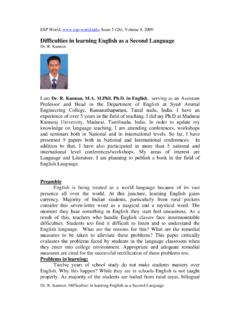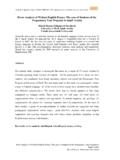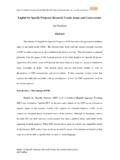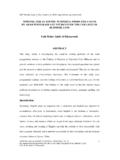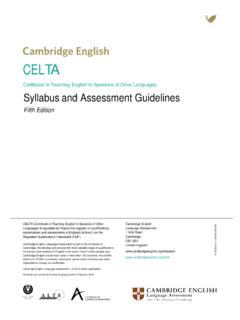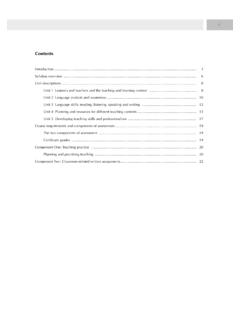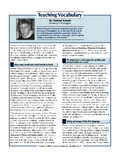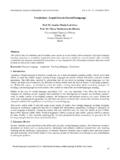Transcription of ROLE OF MOTHER TONGUE - English for Specific Purposes …
1 ESP World, Issue 1 (22), Volume 8, 2009, ROLE OF MOTHER TONGUE IN learning English FOR Specific Purposes Galina Kavaliauskien 1 ROLE OF MOTHER TONGUE IN learning English FOR Specific Purposes Galina Kavaliauskien Mykolas Romeris University, Vilnius, Lithuania Abstract A revival of interest to using a MOTHER TONGUE in the English classroom is stipulated by necessity to improve language accuracy, fluency and clarity. This paper aims at examining students perceptions of the use of MOTHER TONGUE and translation in various linguistic situations. The activities that help raise learners awareness of the language use are described. The findings demonstrate that all learners need a support of MOTHER TONGUE in English classes, but the amount of the native language needed depends on students proficiency in English .
2 The statistical significance of the research results was computed by employing the Statistical Package for the Social Sciences (SPSS) software. Introduction The state-of-the-art teaching of languages is based on the communicative method which emphasizes the teaching English through English . However, the idea of abandoning the native TONGUE is too stressful to many learners, who need a sense of security in the experience of learning a foreign language. In the past, the prevalence of grammar-translation method led to the extraordinary phenomenon: students were unable to speak fluently after having studied the language for a long time.
3 This led to the idea that all use of the MOTHER TONGUE in the language classroom should be avoided (Harmer, 2001:131). Translation has been thought as uncommunicative, boring, pointless, difficult, and irrelevant. ESP World, Issue 1 (22), Volume 8, 2009, ROLE OF MOTHER TONGUE IN learning English FOR Specific Purposes Galina Kavaliauskien 2 Recently there has been a revival of interest to translation due to the shift of its emphasis - to using a MOTHER TONGUE as a resource for the promotion of language learning . Translation develops three qualities essential to all language learning : accuracy, clarity, and flexibility (Ross, 2000:61).
4 Therefore, the use of MOTHER TONGUE and translation can serve as a tool for improving language skills. The goals of this paper are, firstly, to examine students perceptions of the use of MOTHER TONGUE and translation in learning English , and secondly, to describe the activities which raise learners awareness of language use. Comparison between the first language L1 and the second language L2 through translation might help learners activate language usage and serve as a tool to improve English . Research methods employ the survey of students perceptions of the amount of MOTHER TONGUE they need in acquisition of a foreign language at tertiary level and mental translation in various class activities.
5 MOTHER TONGUE and translation in English Language Teaching It is necessary to discriminate between the teaching of translation as a vocational skill and the use of the MOTHER TONGUE in the teaching situation as an aid to language learning . The need for some translation in language learning is usually supported by non-native teachers. Native teachers of English argue that foreign language learning needs as much exposure to the L2 as possible during precious classroom time, and any usage of the L1 or translation is a waste of time. In the past, most methods in L2 language pedagogy dictated that L1 should be prohibited in the classroom. Communicative approaches to language learning in the 1970s and 1980s considered the use of the L1 as undesirable.
6 However, recently the attitude to MOTHER TONGUE and translation in language classes has undergone a positive change. Translation is sometimes referred to as the fifth language skill alongside the other four basic skills of listening, speaking, reading, and writing. Translation holds a special importance at an intermediate ESP World, Issue 1 (22), Volume 8, 2009, ROLE OF MOTHER TONGUE IN learning English FOR Specific Purposes Galina Kavaliauskien 3and advanced level: in the advanced or final stage of language teaching, translation from L1 to L2 and L2 to L1 is recognized as the fifth skill and the most important social skill since it promotes communication and understanding between strangers (Ross, 2000:63).
7 MOTHER TONGUE has potentially both positive and negative consequences: it may serve social and cognitive functions (Carless, 2008:331). It is claimed that students working in groups do not have to speak English all the time. Use of MOTHER TONGUE relates to learner identity. Negative impact of MOTHER TONGUE use is that too much reliance on the L1 may undermine the interaction in English . However good the students are at comprehending authentic reading or listening materials, the majority keeps mentally translating from L2 into L1 and vice versa. This fact makes teachers of foreign languages aware of the importance of translation in language classrooms.
8 Why do students use the MOTHER TONGUE in class? According to J. Harmer (2001:131), a principal cause of the L1 use is required by the activity, if students are linguistically incapable of activating vocabulary for a chosen task. Another reason is that translation is a natural thing to do in language learning , and code-switching between languages is regarded as naturally developmental. The amount of L1 use by particular students may well have to do with differing learner styles and abilities. Evidence from research into the crucial issue of the L1 use in classrooms around the world was analyzed by G. Mattioli (2004). For instance, L1 use in the Chinese classrooms offers evidence that L1 is a valuable tool for socio-cognitive processes in language learning .
9 Another reason for L1 use in the classroom relates to the fostering of a positive affective environment. C. W. Schweers (1999:6) encourages teachers to insert the native language into lessons to influence the classroom dynamic, provide a sense of security and validate the learners experiences. The real usefulness of translation in English classes lies in exploiting it in order to compare grammar, vocabulary, word order and other language points in English and the student s MOTHER TONGUE . According to N. J. Ross (2000), if students are aware of the differences, language interference (transfer) and intervention from their own language are likely to be reduced.
10 ESP World, Issue 1 (22), Volume 8, 2009, ROLE OF MOTHER TONGUE IN learning English FOR Specific Purposes Galina Kavaliauskien 4It is known that linguistic awareness can be either conscious or unconscious (Odlin, 1996).Cross-linguistic similarities and differences can produce positive transfer or negative transfer such as underproduction, overproduction, production errors, and misinterpretation. It should be emphasized that transfer is not always caused by the influence of native language. Numerous studies indicated that both negative and positive transfer between the L1 and L2 was important for development of the interlanguage, the complex system of the learners L2.
